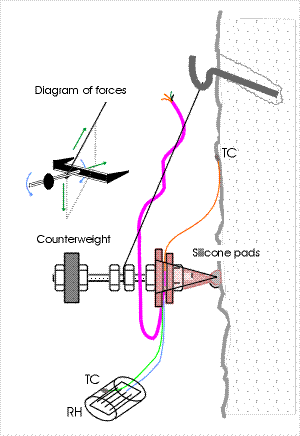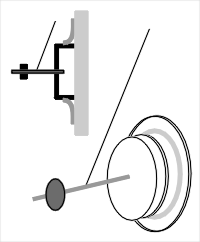
 |
Placing sensors in historic buildings |
It may be difficult to mount sensors to give the maximum useful information while causing the minimum mechanical and visual damage. Wall surface temperature is often an important measurement in uninsulated buildings.
The surface temperature sensor for a hand held instrument is usually a thermocouple in the form of a springy thin strip curved so that the junction can be pressed lightly against the wall. This is quite unsuitable for permanent installation. My suggestion is to make a small thermocouple of type K, which is fairly stiff and springy. This is mounted so that it lies along the wall for the last 10mm to the tip. This is to minimise heat transmission to the tip.
Relative humidity sensors that are bought as units with built in electronics are quite large, typically cylinders about 20 by 200 mm. The actual sensor is tiny: about 4 x 5 mm. If you want to measure the RH within the crack in the wood of an altarpiece you can use a resistive sensor. These can be mounted in tiny spaces, with quite long wires, 20 metres or more, back to the data logger. The logger needs to be of the programmable type, such as the Campbell Scientific.

A cluster of sensors can be lightly and safely pressed against a vertical surface by the construction shown in the sketch.
The suspension wire is fastened above the art. It tilts away from the wall to meet the screwed rod which holds together the measuring cradle. The counterweight is adjusted to balance rotational forces about the point of suspension. The balance of forces is shown on the small inset diagram, which also clarifies the design of the two legged gantry that holds the sensors. The two feet that press on the wall have slippers of silicone rubber.
It is not usually useful to try to measure the RH close to a surface because the temperature gradient is very steep close to the surface and the modest thickness of the sensor, typically 0.5 mm, is comparable to the entire thickness of the boundary layer, thus casting more than usual doubt on the accuracy of the reading.
On the other hand, a RH and a temperature sensor suspended only 50 mm from a wall gives a fairly accurate value for the climate in the centre of the room, particularly if it is screened from radiation from the wall. One can therefore economise on effort by mounting both surface and room sensing devices on the same framework. The surface temperature is measured by the thermocouple lightly sprung against the wall. The probable surface RH is calculated from this temperature and the moisture content of the room air.
Conservators do most of their climate measurements indoors in reasonable bodily comfort with hand-held instruments. The radiant heat striking the sensors is fairly uniformly from all directions. In an unheated church, however, the main source of radiant heat is the measuring body: you. A thermistor temperature sensor can give a reading 2 degrees above ambient if you hold it at a natural distance. The consequence when measuring the RH with a psychrometer can be an error of 10%.
Similar radiation provoked errors can also occur in your absence, anywhere there are significant temperature differences. A study of the climate behind a painting hung on an outside wall of a room, for example, demands careful screening of radiant energy. This can be done by deploying aluminium foil screens that allow air circulation but prevent the sensor "seeing" the surrounding surfaces.
Moisture in walls and its measurement is a vast subject, without any clear best method or much evidence that it can be measured accurately without digging out portions of the wall for weighing.

The RH equilibrium at the surface of the wall, undisturbed by exchange with the room, can be measured in a sealed cup pressed against the surface. This measurement will give some hint about whether the wall is an important source of moisture for the room.
The seal is made with a washer of flat silicone rubber sheet, about 1 mm thick. The hole is cut to a slightly smaller diameter than the cup. When it is stretched over the cup it will naturally tend to cling round the cup and will also spring against the wall. The rim can be made up to 50 mm wide, so that convective air flow is hindered. If the wall is porous a little leakage doesn't matter because the wall buffers the climate and is presumably recharged by whatever source of water fills the exposed part of the wall. If the wall is impermeable then the experiment will be very hard to interpret anyway.

This work is licensed under a Creative Commons Attribution-Noncommercial-No Derivative Works 3.0 License.